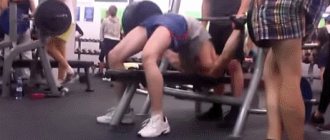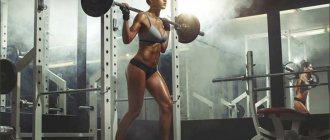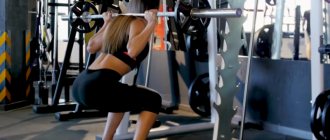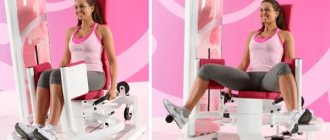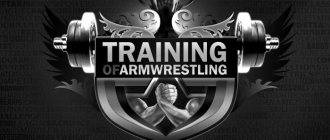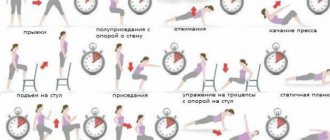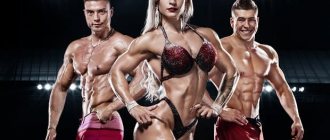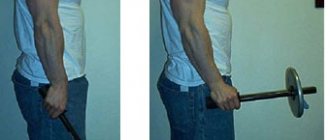Fat and Muscle: What's the Difference?
Even if you remove fat (for example, by fasting), muscles will not appear. Instead, there will be saggy, loose skin and other unaesthetic and unhealthy manifestations. And all because muscle and fat tissue have different purposes.
Fat is a reserve source of energy for the body. If, for example, a person has absolutely nothing to eat, then for some time (more precisely, up to 25 days) he will live due to the gradual consumption of fat deposited in the body.
The composition of muscles mainly includes protein (which is practically absent in fat). Muscles allow a person to stand upright and move in every possible way.
And since muscles and fat have different roles, it is impossible to simply reduce fat reserves and build muscle in this way. To build muscle, the body needs more calories. But at the same time, thanks to the same calories, fats are also formed. This is how the human body works. How to resolve this contradiction? It's simple: first you need to burn fat. And then, in its place, build muscle.
When it's possible?
And while the body is bad at doing two opposite things at once, there are several situations where fat loss and muscle growth occur at the same time.
Beginners
When people first start training, their strength increases quickly and their muscles respond easily to the load. A beginner’s body easily reacts to even the slightest stimuli, unlike those who have been practicing regularly for a long time and are forced to use all possible and impossible approaches and tricks in order to progress.
Therefore, at first, a beginner can lose weight and gain a little muscle at the same time. Strength training and enough protein can sometimes (but not everyone) be enough, although the effect is very short-lived - a few weeks.
One of the consequences of being overweight is the insensitivity of the body's cells to insulin. When a person begins to regularly train with weights, the sensitivity of muscle cells to insulin improves, and they begin to better accept glucose, because this is the main fuel for work. Fat cells, which were previously overfilled, receive an incentive to get rid of completely “extra” energy. This looks like the process of turning fat into muscle, when a person practically does not change in weight, but becomes slimmer and more prominent.
The slimmer a person becomes, the longer he trains, the more this effect fades away - fat cells are no longer so full that they lose fat easily, and muscles are not so untrained that they respond to any load with growth.
Training after the break
People who used to exercise regularly and were in good shape, but had to take a long break from training, often see themselves getting back into shape much faster than those who train from scratch (). They seem to magically replace fat with muscle.
In fact, muscles remember previous physical training even when they atrophy. A simplified mechanism looks like this:
Each cell of the body has inside itself a nucleus, which contains DNA with genetic information, with the help of which the cell can be copied. Muscle cells are very large and long, they are thousands of times larger than other cells in the body, and in order to maintain their volume (and even more so to increase), they need only one nucleus, which carries genetic information to assemble new proteins.
Research has shown that under the influence of strength training, muscle cells receive new nuclei to make the process faster and more efficient - due to their fusion with dormant, inactive cells, called satellite or stem cells, which are located between muscle fibers.
These cells give their nuclei to the muscles. When muscles atrophy, additional nuclei are not lost anywhere and remain in the cell (,). This way, when you return to training, the extra nuclei are already there and can quickly begin synthesizing new protein for muscle growth. This is why for those who return to training after a break, the muscles grow very quickly - they do not so much grow as return to their previous shape.
Chemists
Anabolic steroids and other drugs allow a person to go beyond the limits of normal physiology and do things that mere mortals can only dream of: gain muscle without fat (or even with fat loss), burn fat without losing muscle, maintain minimal body fat and a lot of muscle all year round. .
How to properly turn fat into muscle
To do this, you must follow two basic rules.
- Eat properly.
- Exercise your body physically in the gym or at home.
At the same time, you should know: it is impossible to get a quick result. You need to be patient, be persistent in achieving your goal, and most importantly, adhere to certain comprehensive measures:
- understand what proper nutrition is. This is a food that is low in carbohydrates and high in protein. It is easy to find out about such products from the Internet and other sources, and therefore we will not dwell on this in detail now;
- Having learned everything about products, establish the process of proper nutrition. First of all, avoid foods containing fast carbohydrates. It's all floury, buttery, sweet. Such products contain a lot of glucose, and in order to burn fat, a deficiency must form in the body;
- Another important rule is that the body must expend more calories than it consumes. To do this, you need to include low-calorie foods in your daily diet. What it is is again easy to find on your own;
- You should train fully at least 3 times a week. At the same time, the training program should be structured in such a way as to expend as much energy as possible;
- even if the fat lies in one place, training should nevertheless be comprehensive. That is, it is necessary to load all the muscles, and not just one. Removing fat deposits from only one part of the body and building muscle there is a utopia. This can be done only by loading the entire body as a whole;
- after training, the body and muscles need complete rest for at least 48 hours;
- Along with training, it is allowed to take special sports nutrition and fat burners, but for this you must first consult with a doctor.
Separately, it should be said about diet. Most experts say that no strict restrictions on food are necessary in this case. Diet alone, without training loads, will not turn fat into muscle. On the contrary, the body, deprived of the required amount of food, will begin to extract additional energy from muscle fibers, breaking them down. Well, then why do we need grueling training?
I’ve heard a lot of talk about how muscles grow under fat, the weight doesn’t go away, and we don’t see the desired shape in the mirror. Many say that we need to do more aerobic exercise, others prefer to put increased pressure on the problem area, i.e. engage locally. For example, pump up your abs throughout the day or stretch a dumbbell while watching TV. Of course, it won’t get worse, but we are unlikely to be able to achieve the desired results, that is, correct the problem area. Then I repeatedly heard this version of the conversation that, they say, I went on a strict diet for 3 months, lost so much weight and without training. That’s right, but the catch is that with strict diets we lose not only fat mass, but most often muscle mass as well. This is where the cornerstone emerges - one cannot exist without the other. 1) Diet, or, more correctly, a nutritious diet with a predominance of protein foods, which you may have to maintain for life. 2) That same “rocking chair” that is so unloved by women - it is needed regularly and seriously, and not to show off the latest Nike collection. 3) Moderate aerobic exercise. I would like to immediately clarify that aerobic training does not depend on the title of the lesson, but on the heart rate during the lessons. If you work with a heart rate of 130-160 beats per minute, you get endurance training. This is what helps burn fat. When the pulse rises above 170-175 beats, this is already strength training, which allows you to pump up your muscles. If our goal is weight loss, this does not mean that strength exercises can be neglected. On the contrary, training with weights is simply necessary: after all, the more muscle mass you have, the more energy your body will spend at rest. In addition, strength training will help reduce “volume” by increasing muscle tone and give your figure a more toned and aesthetic appearance. This is where the most interesting thing is: if we want to correct this or that part of the body, but at the same time we think that we are women and we don’t need a lot of weight, and the dumbbell should be small, and definitely pink, then we don’t need to expect results. Why? Yes, because each of you, like any woman, goes to the grocery store, and even if you don’t walk, but drive, you still have to carry the bag of groceries from the parking lot to the kitchen yourself, i.e. with your HANDS, and your BICEPS and TRAPEZES, lift this package several times - opening and closing doors, pressing the elevator button, and so on. So, your bag of groceries in its lightest form weighs no less than 5-6 kg. What about mothers who already have children? Your child already weighs 3-4 kg at birth, and you carry him almost all day IN YOUR HANDS, and after six months he is already 8 kg, and by the year - all 10, and although he is already crawling and walking, he still often “ hanging" on mom like a little koala. Therefore, your hands have long been accustomed to SUCH a load of weight. There is also a very common myth that muscles grow under fat. Or they will start to grow altogether. And god! I'll become like a man! Nope, won't happen. Male hormones, androgens, are responsible for muscle growth in our body. Their level in the female body is tens (!) times lower than in the male body. Therefore, the return from training in terms of muscle growth in women is much lower. If men have to take steroids to build muscle mass, then what can we say? Therefore, we should not be afraid to go to the gym; strength training, unless, of course, it is a professional sport, will give us the opportunity to tone our muscles and not lose muscle mass. Weight: 70.6 kg Olga
Sample program for muscle gain
Before starting a set of exercises, it is necessary to organize warm-up exercises. Completing within 10-15 minutes is considered sufficient:
- circular swings of the arms at the elbow or shoulders;
- turning the body in different directions;
- 10 or 20 traditional squats.
It is recommended to start training by working out large muscle groups. The first exercises in the form of squats can be performed with an empty bar. Next, it is recommended to use plates weighing 5 kg and perform similar exercises with a load of 3 sets of 6 or 8 repetitions.
Next, it is recommended to work the pectoral muscles. To do this, it is fashionable to use the exercise on a bench in a lying position. To warm up, an empty bar is lifted, then a load of 5 kg is added, and a chest press is performed in an amount of 43 to 5 sets of 8 or 10 repetitions.
An effective exercise for working the back muscles is considered to be performing deadlifts in the amount of 3 repetitions and 6-8 repetitions. To work on the biceps muscles in the gym and at home, it is recommended to use dumbbell lifts weighing 2 or 3 kg. There are quite a few techniques for performing exercises with dumbbells, so there is always the opportunity to diversify your training program.
The final stages of the training program are exercises for the abs and deltoid muscles. To work out the abdominal area, body lifts on a sports bench and various types of crunches are recommended, the number of which can vary from 10 to 30. After completing the complex, you need to do a cool-down and include stretching exercises.
